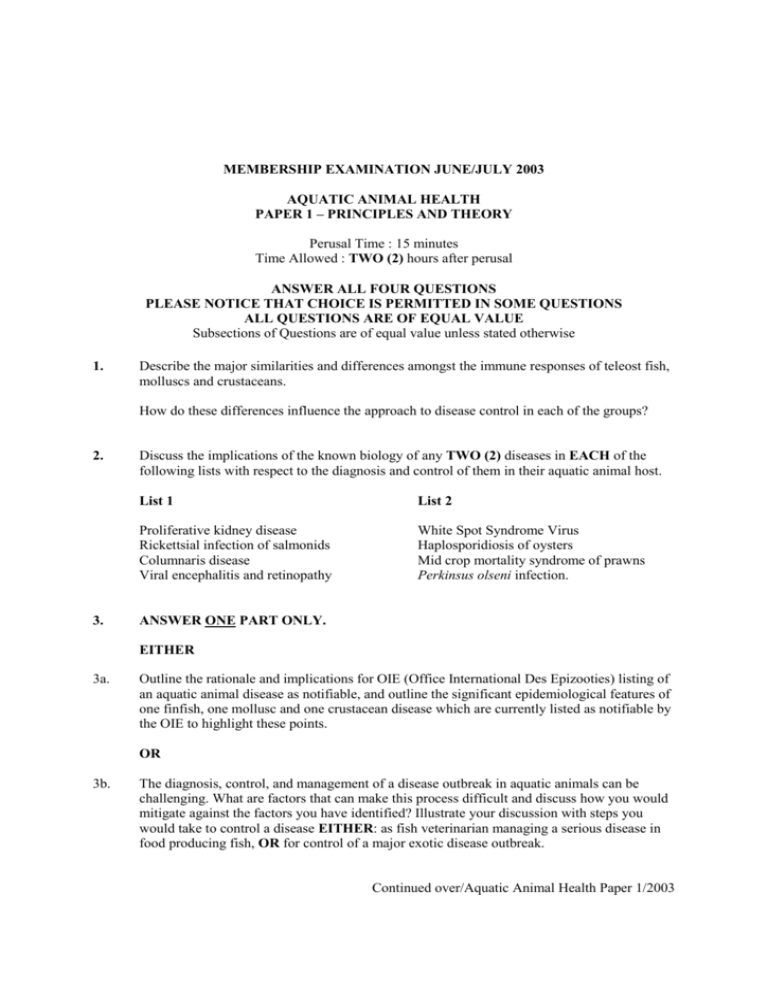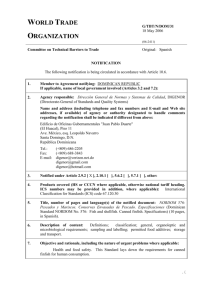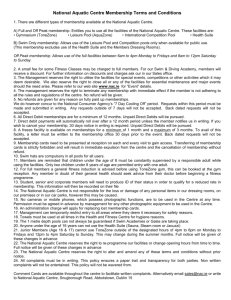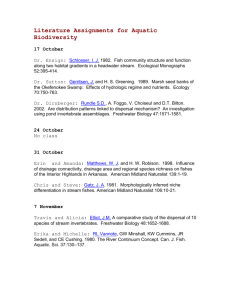Aquatic Animal Health
advertisement

MEMBERSHIP EXAMINATION JUNE/JULY 2003 AQUATIC ANIMAL HEALTH PAPER 1 – PRINCIPLES AND THEORY Perusal Time : 15 minutes Time Allowed : TWO (2) hours after perusal ANSWER ALL FOUR QUESTIONS PLEASE NOTICE THAT CHOICE IS PERMITTED IN SOME QUESTIONS ALL QUESTIONS ARE OF EQUAL VALUE Subsections of Questions are of equal value unless stated otherwise 1. Describe the major similarities and differences amongst the immune responses of teleost fish, molluscs and crustaceans. How do these differences influence the approach to disease control in each of the groups? 2. 3. Discuss the implications of the known biology of any TWO (2) diseases in EACH of the following lists with respect to the diagnosis and control of them in their aquatic animal host. List 1 List 2 Proliferative kidney disease Rickettsial infection of salmonids Columnaris disease Viral encephalitis and retinopathy White Spot Syndrome Virus Haplosporidiosis of oysters Mid crop mortality syndrome of prawns Perkinsus olseni infection. ANSWER ONE PART ONLY. EITHER 3a. Outline the rationale and implications for OIE (Office International Des Epizooties) listing of an aquatic animal disease as notifiable, and outline the significant epidemiological features of one finfish, one mollusc and one crustacean disease which are currently listed as notifiable by the OIE to highlight these points. OR 3b. The diagnosis, control, and management of a disease outbreak in aquatic animals can be challenging. What are factors that can make this process difficult and discuss how you would mitigate against the factors you have identified? Illustrate your discussion with steps you would take to control a disease EITHER: as fish veterinarian managing a serious disease in food producing fish, OR for control of a major exotic disease outbreak. Continued over/Aquatic Animal Health Paper 1/2003 Continued/Aquatic Animal Health Paper 1/2003 4. ANSWER ONE PART ONLY. EITHER 4a. i Briefly describe the function of the swim bladder in teleost finfish. ii. Compare and contrast the anatomical structure of a swim bladder of a physostomic and a pysoclistous finfish. iii. What is the role of the rete mirabile that is associated with some finfish swim bladders? iv. Explain the common aetiologies for swim bladder distension and collapse in teleost finfish. i. Describe using diagrams how fish can osmoregulate in marine and freshwater environments. ii. How can osmoregulatory imbalance arise in finfish? iii. How can the understanding of the above process be used to effect during treatment of osmoregulatory imbalance? OR 4b. END OF PAPER MEMBERSHIP EXAMINATION JUNE/JULY 2003 AQUATIC ANIMAL HEALTH PAPER 2 - APPLIED Perusal Time : 15 minutes Time Allowed : TWO (2) hours after perusal ANSWER FOUR (4) QUESTIONS ONLY ALL QUESTIONS ARE OF EQUAL VALUE Subsections of Questions are of equal value unless stated otherwise 1. ANSWER ONE PART ONLY EITHER 1a. A freshwater crayfish farmer has discovered a disease in his ponds that is affecting about 30% of all ages of stock. He is finding dead and moribund crayfish many with white discolouration of the tail muscles. Give the steps you would take to establish a diagnosis, manage the problem and help prevent further occurrence. OR 1b. A peneid prawn farmer has noticed low survival of post larvae (PL) in his hatchery. List the possible causes and briefly discuss control measures he may take. 2. Give a brief description of the chemical processes that operate within a recirculating filtration system that could be used in an intensive barramundi grow out establishment. Diagrammatically present a design for such a system and in note form highlight the function of each component. What advice would you give a farmer to establish and maintain such a system? 3. Outline the preoperative, operative and post operative procedures you would undertake for the successful removal of a skin growth from an ornamental koi carp. 4. Discuss issues and indications regarding the use of TWO (2) chemotherapeutic agents for each of the following: a. b. c. food producing finfish (e.g. salmonid, silver perch or barramundi) prawn hatchery abalone farm Continued over/Aquatic Animal Health Paper 2/2003 Continued /Aquatic Animal Health Paper 2/2003 5. ANSWER ONE PART ONLY EITHER 5a. Discuss issues relating to the use of anti-fouling agents on and in the region of an aquaculture establishment. OR 5b. List and describe with examples the major types of risk posed to aquaculture by algal blooms. 6. Briefly describe or list the clinical signs, pathogenesis, diagnosis, treatment and prevention of any THREE (3) of the following diseases: a. b. c. d. e. f. g. 7 Whirling disease of salmonids Ultraviolet light damage in finfish Ichthyophoniasis Costiasis Yersiniosis Rancid food toxicity Bacterial gill disease Briefly describe or list the gross and histological pathology and the epidemiological features of any THREE (3) of the following diseases: a. b. c. d. e. f. Bonamiasis of molluscs Nocardiosis of Pacific oysters Monodon Baculovirus Vibrio harveyi infection of molluscs or crustaceans Yellowhead virus infection of Peneaid prawns Herpes virus of molluscs END OF PAPER




